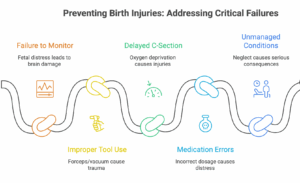Bringing a child into the world should be a joyous experience. But what happens when medical errors during labor and delivery turn that joy into heartbreak? This article explores medical malpractice in childbirth, helping you understand your rights and options if something went wrong.
Understanding Medical Malpractice in Childbirth: An Overview
Medical malpractice occurs when a healthcare professional’s negligence – a deviation from accepted medical standards – results in injury to a patient. In childbirth, this could involve mistakes made by doctors, nurses, or other hospital staff during pregnancy, labor, or delivery. These mistakes can have devastating, lifelong consequences for both mother and child. The key is proving that the medical professional’s actions fell below the expected standard of care and directly caused the injury.
Common Examples of Medical Malpractice During Labor and Delivery
Many different types of errors can constitute medical malpractice during labor and delivery. Some of the most frequent include:
- Failure to monitor fetal distress: Electronic fetal monitoring is crucial. Failing to recognize and respond appropriately to signs of fetal distress, such as a dangerously slow heart rate, can lead to brain damage.
- Improper use of forceps or vacuum extractors: These tools can assist delivery, but misuse can cause skull fractures, brain bleeds, or nerve damage in the baby, and vaginal tearing or pelvic floor damage in the mother.
- Delaying or failing to perform a necessary Cesarean section (C-section): When vaginal delivery poses a risk to the mother or baby, a C-section is often necessary. Delays can lead to oxygen deprivation and serious injuries.
- Medication errors: dosage or administration of medications like Pitocin (used to induce or augment labor) can cause uterine rupture or fetal distress.
- Failure to manage gestational diabetes or preeclampsia: These conditions require careful monitoring and management. Neglecting them can have serious consequences for both mother and baby.
- Anesthesia errors: Improper administration of epidurals or spinal anesthesia can lead to nerve damage, headaches, or even paralysis in the mother.

How Medical Errors Can Harm Mother and Child
The consequences of medical errors during labor and delivery can be severe and long-lasting. For the baby, these errors can lead to conditions like:
- Cerebral palsy: A group of disorders affecting movement and muscle tone, often caused by oxygen deprivation during birth.
- Hypoxic-ischemic encephalopathy (HIE): Brain damage due to lack of oxygen.
- Brachial plexus injury (Erb’s palsy): Nerve damage in the arm and shoulder, often caused by excessive force during delivery.
- Seizures: Caused by brain damage.
- Intellectual disabilities: Resulting from brain damage.
For the mother, errors can lead to:
- Uterine rupture: A tear in the uterus, often caused by excessive Pitocin.
- Postpartum hemorrhage: Excessive bleeding after delivery.
- Infections: Resulting from poor hygiene or surgical errors.
- Pelvic floor injuries: Leading to incontinence or pelvic pain.
- Emotional trauma: Post-traumatic stress disorder (PTSD) after a traumatic birth experience.
The emotional and financial impact on families is immense. Beyond the medical bills and ongoing care costs, families face the emotional toll of caring for a child with disabilities, often requiring lifelong support.
Proving Medical Malpractice Occurred During Labor
Proving medical malpractice requires demonstrating that the medical professional’s actions fell below the accepted standard of care and directly caused the injury. This often involves:
- Medical records review: A detailed analysis of the mother’s and baby’s medical records to identify errors or deviations from standard protocols.
- Expert testimony: Medical experts in obstetrics, neonatology, and other relevant fields provide opinions on whether the care provided was negligent and whether that negligence caused the injury.
- Establishing causation: Demonstrating a direct link between the negligence and the resulting injury.
A successful lawsuit, for instance, involved a hospital failing to properly monitor a woman with preeclampsia. As a result, she suffered a stroke, leaving her with permanent disabilities. The jury found the hospital negligent and awarded the woman significant compensation.
What Damages Can Be Recovered in a Childbirth Malpractice Claim?
If medical malpractice is proven, families may be able to recover damages to compensate them for their losses. These damages can include:
- Medical expenses: Past and future costs of medical care, therapy, and rehabilitation.
- Lost income: Compensation for lost wages due to the mother’s inability to work or the need to care for the child.
- Pain and suffering: Compensation for the physical and emotional pain experienced by the mother and child.
- Special needs care: Costs associated with caring for a child with disabilities, such as specialized equipment, therapies, and education.
Seeking Legal Help for Birth Injuries Resulting from Medical Malpractice
If you suspect that medical malpractice played a role in your child’s birth injury or your own injuries during labor, it is important to seek legal advice from an experienced medical malpractice attorney as soon as possible. A lawyer can evaluate your case, gather evidence, and help you understand your legal options.
Organizations like the United Cerebral Palsy Association (UCPA) and the National Dissemination Center for Children with Disabilities (NICHCY) offer support and resources for families of children with disabilities.
Preventing Medical Malpractice in Future Pregnancies and Labor
While you cannot undo the past, you can take steps to minimize the risk of medical errors in future pregnancies. These include:
- Choosing a qualified and experienced healthcare provider: Research your doctor’s credentials and experience.
- Asking questions and advocating for yourself: Be actively involved in your care and don’t hesitate to ask questions about any concerns you have.
- Getting a second opinion: If you are unsure about a diagnosis or treatment plan, seek a second opinion from another medical professional.
- Ensuring adequate fetal monitoring: Insist on continuous fetal monitoring during labor and delivery.
Hospitals can also implement preventative measures, such as:
- Implementing standardized protocols: Following established guidelines for managing labor and delivery.
- Providing ongoing training for staff: Ensuring that medical staff are up-to-date on the latest medical advancements and best practices.
- Using checklists: Employing checklists to ensure that all necessary steps are taken during labor and delivery.
- Encouraging open communication: Fostering a culture of open communication among medical staff to prevent errors.
The information provided here is for general knowledge and informational purposes only, and does not constitute legal advice. It is essential to consult with a qualified attorney to discuss the specifics of your situation and explore your legal options.





